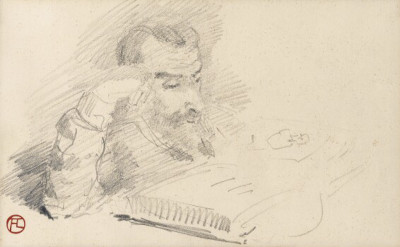Homme lisant, or Man Reading, was a drawing by Henri de Toulouse-Lautrec which was sold at Sotheby's in 2019 for 10,000 Euros. Relatively little is known about it, which can be the case with some of his lesser known sketches.
We see an elderly man with a long beard who appears to be lying down. He rests his head against his right hand whilst presumably reading a book, as the title suggests. The artwork is stamped in the bottom left corner which confirms its authenticity. The facial features and resting arm are fairly well developed, but the rest of the scene is eithe blank or with just a few rough pencil marks. This looks like the sort of composition that would appear within the artist's sketchbooks, some of which were separated and sold as individual pages. Others would be gifted to friends and family, often to the subject themselves. The entry about this drawing on the Sotheby's listed suggests that a sketch of a dog was to be found on the opposing side. He would often use paper in this manner, making use of every square inch for his musings and studies. Portraiture was an important genre within this artist's career and he perfected this ability by constant practice, carrying sketchbooks around with him in order to work whenever he felt that desire.
Most of this artist's drawings were simply done in pencil, but sometimes he might run a pen over the top to increase the contrast. The majority of these drawings are now worth in the tens of thousands of Euros, with a little bit more for the more developed ones, or where they have a direct connection to a famous painting, such as Divan Japonais, Jane Avril or Ambassadeurs, Aristide Bruant. He practiced throughout his lifetime and never grew bored of his highly prized sketchbooks, some of which remain intact today and have been researched and documented in good detail by their respective owners. He liked to see and record intimate moments, where he might find someone in a personal situation that he felt lucky to witness. Many allowed him to capture these scenes within his work and he would often draw these first, before returning to his studio to complete a much more developed piece, often in oils.
The identity of the individual in this portrait is not known, but there maybe evidence elsewhere such as in the catalogue raisonnes of his career. Some details still remain in French but have yet to be translated into English and overall there remains a large knowledgebase about his life, which has proven popular with academics and the public alike. The original artworks are now spread between private collections plus a number of major art galleries and museums in the US and Europe, as well as in the museum dedicated to his life which is situated in the south of France. His legacy and reputation remain just as strong today as they ever have been.




